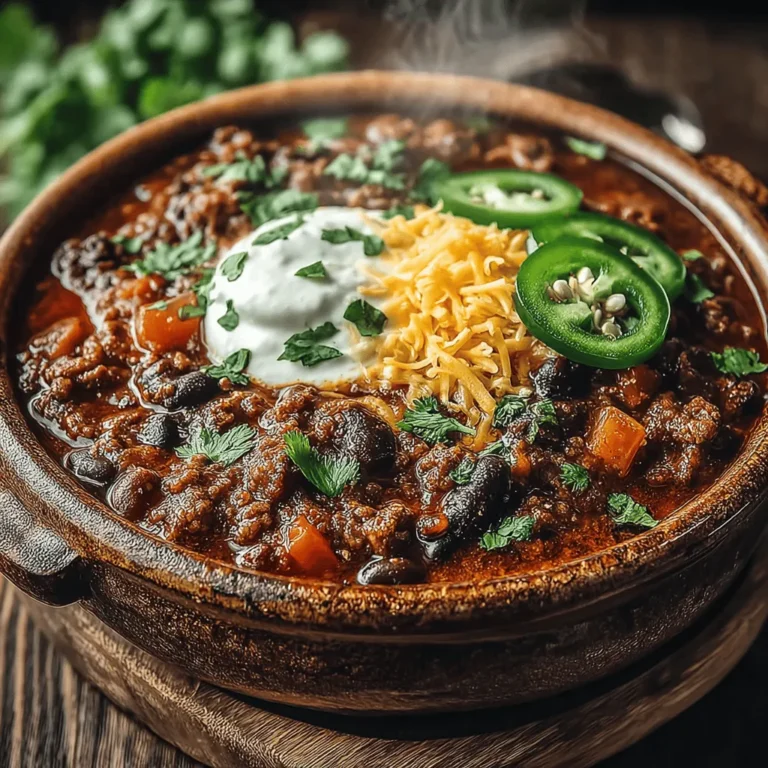Introduction
Spicy Southwestern Beef and Bean Chili is a hearty dish that embodies the rich flavors of Southwestern cuisine. Perfect for chilly evenings or gatherings, this chili combines ground beef, beans, and spices for a satisfying meal. In this blog post, we will explore the step-by-step process of making this delicious chili, discuss the health benefits of the ingredients, and provide helpful insights for enhancing your chili experience.
Ingredients
– 1 pound ground beef
– 1 can (15 oz) kidney beans, drained and rinsed
– 1 can (15 oz) black beans, drained and rinsed
– 1 can (14.5 oz) diced tomatoes with green chilies
– 1 medium onion, diced
– 3 cloves garlic, minced
– 2 tablespoons olive oil
– 2 tablespoons chili powder
– 1 tablespoon ground cumin
– 1 teaspoon smoked paprika
– 1 cup beef broth
– Salt and pepper, to taste
– Optional toppings: shredded cheese, sour cream, chopped jalapeños, and fresh cilantro
Instructions
1. Heat olive oil in a large pot over medium heat.
2. Add the diced onion and minced garlic, sautéing until the onion becomes translucent, about 5 minutes.
3. Increase the heat to medium-high and add the ground beef, cooking until browned, breaking it apart with a spoon.
4. Stir in the chili powder, cumin, smoked paprika, salt, and pepper, mixing well to coat the beef and onions.
5. Add the diced tomatoes with green chilies, kidney beans, black beans, and beef broth to the pot.
6. Bring the mixture to a boil, then reduce the heat and let it simmer for at least 30 minutes, stirring occasionally.
7. Taste and adjust seasoning as needed before serving hot with your choice of optional toppings.
Understanding the Ingredients
Ground Beef: The Protein Powerhouse
Ground beef is the cornerstone of this chili, providing rich flavor and texture. Not only does it contribute to the heartiness of the dish, but it is also a significant source of protein and iron, making it a nutritious choice for those looking to build muscle or maintain energy levels.
Beans: A Nutritional Boost
Kidney beans and black beans are the stars of this dish, offering a wonderful texture and a boost of nutrition. These legumes are high in fiber and plant-based protein, making them an excellent addition for a balanced meal. They can help improve digestion and keep you feeling full longer.
Diced Tomatoes with Green Chilies: Flavor Base
Using diced tomatoes with green chilies is crucial for creating a flavorful base for the chili. The tomatoes add acidity, while the green chilies provide a kick of heat, enhancing the overall taste and texture of the dish. This combination also helps to keep the chili moist and rich.
Aromatics: Onions and Garlic
Onions and garlic are essential aromatics that elevate the flavor profile of the chili. They add depth and complexity while also providing health benefits, including antioxidants and immune-boosting properties. Sautéing these ingredients first allows their flavors to infuse the oil, which enriches the entire dish.
Spices: The Heart of the Chili
The combination of chili powder, cumin, and smoked paprika is what truly brings this chili to life. These spices not only add warmth and depth but also offer various health benefits, such as anti-inflammatory properties and a boost to metabolism. Mastering the balance of spices is key to achieving the perfect chili flavor.
Optional Toppings: Customizing Your Bowl
Toppings allow for customization and personalization of your chili experience. Options like shredded cheese, sour cream, chopped jalapeños, and fresh cilantro can enhance the dish’s flavor and presentation. For those with dietary preferences, consider dairy-free cheese or vegan sour cream as alternatives to satisfy all guests.
Step-by-Step Instructions for Making Spicy Southwestern Beef and Bean Chili
Preparing the Ingredients
Efficient ingredient preparation is vital for a smooth cooking process. Begin by measuring out all spices and chopping vegetables. Wash and rinse the beans thoroughly to remove excess sodium and any unwanted residue, ensuring a fresher taste in your chili.
Cooking Process
1. Heating the Olive Oil: Start by heating the olive oil in your pot as this step is crucial for flavor development. The oil should be hot enough to sauté the aromatics without burning them.
2. Browning the Ground Beef: When adding the ground beef, ensure it is well-browned for optimal flavor. Break it apart with a spoon, allowing the meat to sear and develop a nice crust.
3. Sautéing the Vegetables: Timing and heat are essential when sautéing onions and garlic. Cook until the onions are soft and translucent, which usually takes about 5 minutes. This step helps release their natural sugars and enhances the overall flavor of the chili.
Building the Flavor
Once you have sautéed your vegetables and browned the meat, it’s time to build the flavor by adding spices and liquids. Stirring in the spices before the tomatoes and beans allows them to bloom and enhance the overall taste of the chili. Continue with the recipe to create a dish that is both delicious and satisfying.

Incorporating Spices: Techniques for Even Distribution
When preparing Spicy Southwestern Beef and Bean Chili, the even distribution of spices is crucial for achieving a well-rounded flavor profile. To ensure that your spices are evenly incorporated, consider the following techniques:
Toasting Spices
Toasting spices before adding them to your chili enhances their aromatic qualities. In a dry skillet, heat the spices for a few minutes until they become fragrant. This process releases the essential oils, intensifying the flavors.
Layering Flavors
Add spices at different stages of cooking. Start by seasoning your ground beef early in the process to infuse the meat with flavor. Then, add more spices during the simmering phase. This layering technique builds depth and complexity in your chili.
Adding Beans and Tomatoes: How to Achieve the Right Consistency
The right balance of beans and tomatoes is essential for achieving the desired consistency. Here are some tips to ensure your chili has the perfect texture:
Choosing the Right Beans
Different beans provide distinct textures and flavors. Black beans, kidney beans, and pinto beans are popular choices that add heartiness. For a creamier texture, consider using refried beans or mashing some of the beans before adding them to the chili.
Controlling Liquid Levels
When adding tomatoes, be mindful of the liquid content. If using canned tomatoes, drain some of the excess liquid to prevent your chili from becoming too runny. If it’s too thick, you can always add a little beef broth or water during the simmering process.
Simmering to Perfection
Importance of Simmering for Flavor Melding
Simmering is key to allowing the flavors of your chili to meld beautifully. This gentle cooking process enables the spices, beans, and meat to combine, enhancing the overall taste.
Ideal Simmering Time and What to Look For
A simmering time of at least 30 minutes is recommended, but longer simmering (up to 2 hours) can deepen the flavors. Look for a rich, thick consistency and ensure the beans are tender yet not mushy.
Final Touches
Adjusting Seasoning: How to Taste and Balance Flavors
Before serving your chili, taste it and make any necessary adjustments. You may want to add more salt, a splash of vinegar for acidity, or a touch of sugar to balance out the heat. Remember to adjust gradually, as it’s easier to add than to subtract.
Serving Suggestions and Presentation Tips
For an appealing presentation, serve your chili in bowls garnished with fresh cilantro, a dollop of sour cream, or shredded cheese. Consider pairing your chili with cornbread, tortilla chips, or a fresh salad to create a complete meal.
Health Benefits of Spicy Southwestern Beef and Bean Chili
Nutritional Breakdown
Spicy Southwestern Beef and Bean Chili is not only delicious but also nutritious. A standard serving typically contains around 350-450 calories, with a good balance of protein, carbohydrates, and dietary fiber. Compared to traditional chili recipes, this version offers more fiber and healthier fats due to the inclusion of beans.
Benefits of a High-Protein Meal
With beef as its primary protein source, this chili supports muscle health and provides sustained energy. The high protein content promotes satiety, making it an excellent choice for those looking to maintain or lose weight.
Antioxidants and Spices
The spices used in this chili, such as cumin and chili powder, possess anti-inflammatory properties, while tomatoes are rich in lycopene, an antioxidant linked to various health benefits. Together, they contribute to a dish that is as beneficial as it is flavorful.
Variations and Customizations
Vegetarian and Vegan Options
For a vegetarian or vegan version, substitute ground beef with plant-based alternatives like lentils, crumbled tofu, or textured vegetable protein (TVP). Adjust the bean ratios to maintain a hearty texture while adding a variety of vegetables for flavor and nutrition.
Heat Level Adjustments
If you prefer a milder chili, reduce the amount of chili powder and fresh peppers. Conversely, for a spicier dish, consider adding jalapeños, serrano peppers, or even a dash of hot sauce to kick it up a notch.
Creative Serving Ideas
Beyond the traditional bowl, consider serving your chili over rice for a hearty meal or using it as a filling for tacos or burritos. It pairs well with sides like cornbread, a light salad, or even a crisp beer for a complete dining experience.
Conclusion
Spicy Southwestern Beef and Bean Chili is not just a meal; it’s an experience that brings warmth and comfort to the table. With this detailed recipe and insights into its ingredients and health benefits, you can enjoy a dish that is as nourishing as it is flavorful. Whether you choose to stick with the classic recipe or customize it to suit your taste, this chili is sure to become a favorite in your culinary repertoire. Enjoy the vibrant flavors and the satisfaction of homemade comfort food!


